Intel NUC10i7FNH Frost Canyon Review: Hexa-Core NUC Delivers a Mixed Bag
by Ganesh T S on March 2, 2020 9:00 AM ESTBAPCo SYSmark 2018
The Intel NUC10i7FNH (Frost Canyon) was evaluated using our Fall 2018 test suite for small-form factor PCs. In the first section, we will be looking at SYSmark 2018.
BAPCo's SYSmark 2018 is an application-based benchmark that uses real-world applications to replay usage patterns of business users in the areas of productivity, creativity, and responsiveness. The 'Productivity Scenario' covers office-centric activities including word processing, spreadsheet usage, financial analysis, software development, application installation, file compression, and e-mail management. The 'Creativity Scenario' represents media-centric activities such as digital photo processing, AI and ML for face recognition in photos and videos for the purpose of content creation, etc. The 'Responsiveness Scenario' evaluates the ability of the system to react in a quick manner to user inputs in areas such as application and file launches, web browsing, and multi-tasking.
Scores are meant to be compared against a reference desktop (the SYSmark 2018 calibration system, a Dell Optiplex 5050 tower with a Core i3-7100 and 4GB of DDR4-2133 memory to go with a 128GB M.2 SATA III SSD). The calibration system scores 1000 in each of the scenarios. A score of, say, 2000, would imply that the system under test is twice as fast as the reference system.
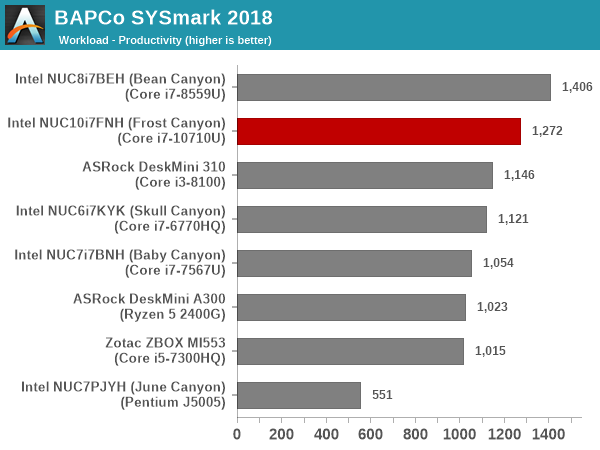
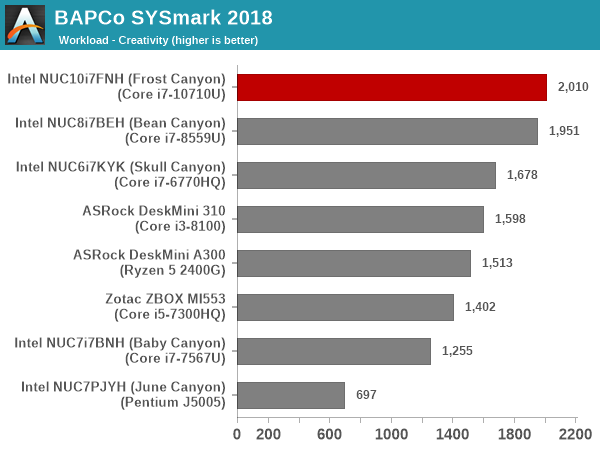
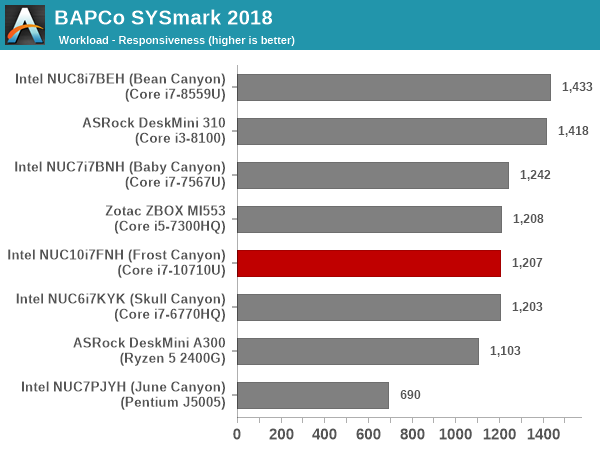
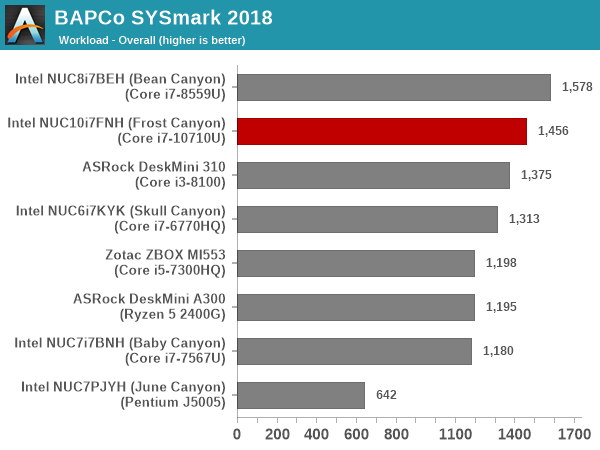
SYSmark 2018 also adds energy measurement to the mix. A high score in the SYSmark benchmarks might be nice to have, but, potential customers also need to determine the balance between power consumption and the efficiency of the system. For example, in the average office scenario, it might not be worth purchasing a noisy and power-hungry PC just because it ends up with a 2000 score in the SYSmark 2014 SE benchmarks. In order to provide a balanced perspective, SYSmark 2018 also allows vendors and decision makers to track the energy consumption during each workload. In the graphs below, we find the total energy consumed by the PC under test for a single iteration of each SYSmark 2018 workload. For reference, the calibration system consumes 5.36 Wh for productivity, 7.71 Wh for creativity, 5.61 Wh for responsiveness, and 18.68 Wh overall.
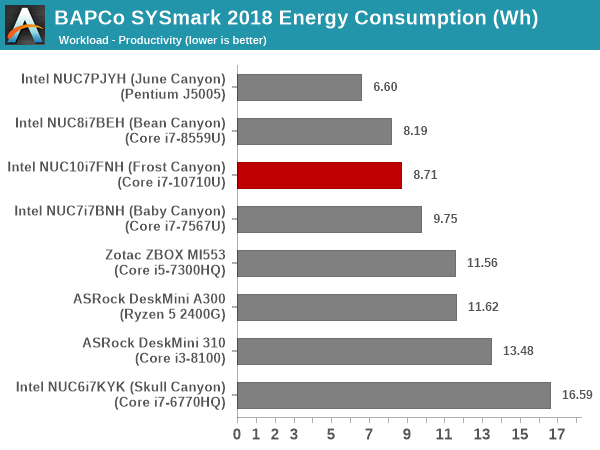
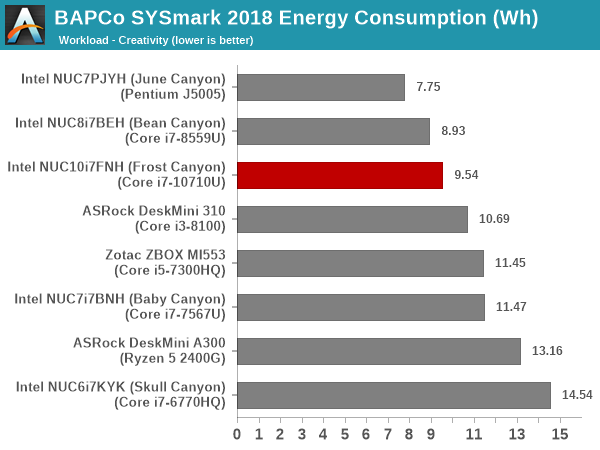
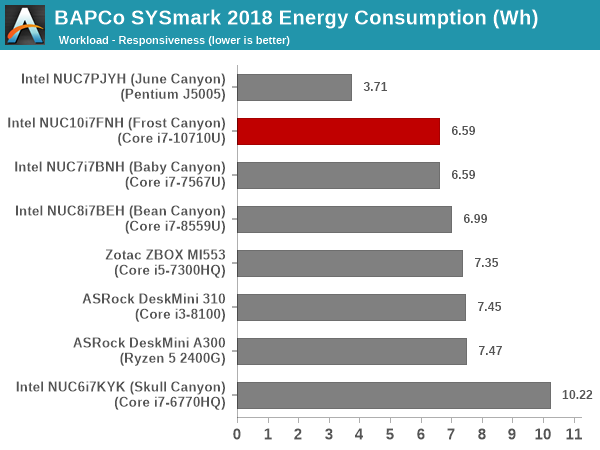
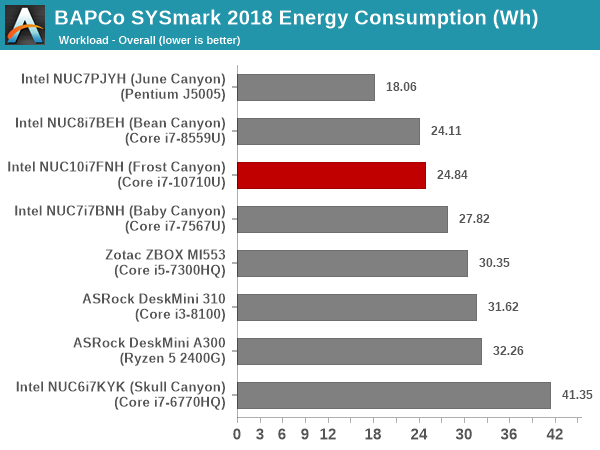
The 'Creativity' workload benefits from the extra cores in Frost Canyon compared to the Core i7-8559U in the Bean Canyon. Our Bean Canyon review configuration is also equipped with a WD Black 3D NVMe SSD (PCIe 3.0 x4) that delivers much better performance compared to the PCIe 3.0 x2 Kingston A1000-class in the Frost Canyon configuration. This results in the responsiveness score for the NUC10i7FNH coming in the middle of the pack compared to the other systems in the sample set. This pulls down the Frost Canyon NUC well below the Bean Canyon NUC in the overall score. The energy consumption is also worse off.










85 Comments
View All Comments
HStewart - Tuesday, March 3, 2020 - link
I will say that evolution of Windows has hurt PC market, with more memory and such, Microsoft adds a lot of fat into OS. As as point of sale developer though all these OS, I wish Microsoft had a way to reduce the stuff one does not need.Just for information the original Doom was written totally different to games - back in old days Michael Abrash (a leader in original game graphics) work with John Carmack of Id software for Doom and Quake, Back then we did not have GPU driven graphics and code was done in assembly language.
Over time, development got fat and higher level languages plus GPU and drivers. came in picture. This also occurred in OS area where in 1992 I had change companies because Assembly Language developers started becoming a dying breed.
I think part of this is Microsoft started adding so many features in the OS, and there is a lot of bulk to drive the windows interface which is much simpler in older versions.
If I was with Microsoft, I would have options in Windows for super trim version of the OS. Reducing overhead as much as possible. Maybe dual boot to it.
HStewart - Tuesday, March 3, 2020 - link
I have some of original Abrash's books - quite a collectors item now a dayshttps://www.amazon.com/Zen-Graphics-Programming-2n...
HStewart - Tuesday, March 3, 2020 - link
And even more - with Graphics Programming Black book - almost $1000 nowhttps://www.amazon.com/Michael-Abrashs-Graphics-Pr...
Qasar - Tuesday, March 3, 2020 - link
you do know there are programs out there that can remove some of the useless bloat that windows auto installs, right ? maybe not to the extent that you are referring to, but ot is possible. on a fresh reinstall of win 10, i usually remove almost 500 megs of apps that i wont use.erple2 - Saturday, March 14, 2020 - link
This is an age old argument that ultimately falls flat in the face of history. "Bloated" software today is VASTLY more capable of the "efficient" code written decades ago. You could make the argument that we might not need all of the capabilities of software today, but I rather like having the incredibly stable OS's today than what I had to deal with in the past. And yes, OS's today are much more stable than they were in 1992 (not to mention vastly more capable)Lord of the Bored - Thursday, March 5, 2020 - link
My recollection is that was Windows Vista, not XP. XP was hitting 2D acceleration hardware that had stopped improving much around the time Intel shipped their first graphics adapter.Vista, however, had a newfangled "3D" compositor that took advantage of all the hardware progress that had happened since 1995... and a butt-ugly fallback plan for systems that couldn't use it(read as: Intel graphics).
And then two releases later, Windows 8 dialed things way back because those damnable Intel graphics chips were STILL a significant install base and they didn't want to keep maintaining multiple desktop renderers.
...
Unless the Vista compositor was originally intended for XP, in which case I eat my hat.
TheinsanegamerN - Monday, March 2, 2020 - link
you dont need a 6 core CPU for back office systems or report machines either. So they wouldnt buy this at all.Dell, HP, ece make small systems with better CPU power for a lower price then this. The appeal of the NUCs was good CPUs with iris level GPUs isntead of the UHD that everyone else used.
PeachNCream - Monday, March 2, 2020 - link
The intention of the NUC was to provide a fairly basic computing device in a small and power efficient package. Iris models were something of an aberration in more recent models. In fact, the first couple of NUC generations used some of Intel's slowest processors available at the time. timniva - Tuesday, March 3, 2020 - link
The point is that if you're making a basic computing device why even go beyond 4 cores. I kind of want a NUC as a basic browsing computer that takes up little space. I can see these being used in the office too. Many use cases for a device like this with 6 or more cores in the office, especially for folks in engineering fields running Matlab or doing development/compiling. However, in almost all of these use cases having a stronger graphics package helps, never mind gaming. Taking a step back in the GPU side, especially given what AMD is doing right now and this being in response to the competition, doesn't make much sense. Perhaps this is just to hold them over until Intel fully transitions to using AMD GPUs in the future?Lord of the Bored - Thursday, March 5, 2020 - link
Can I just say how much I love that four cores is now considered a "basic" computing device? It leaves me suffused with a warm glow of joy.